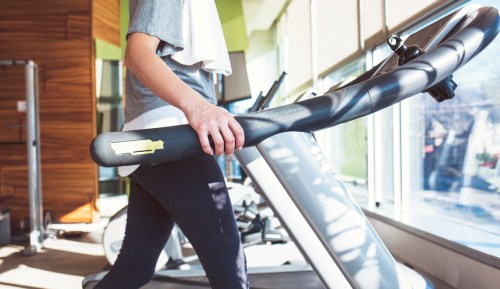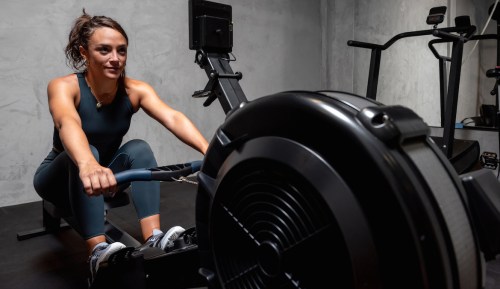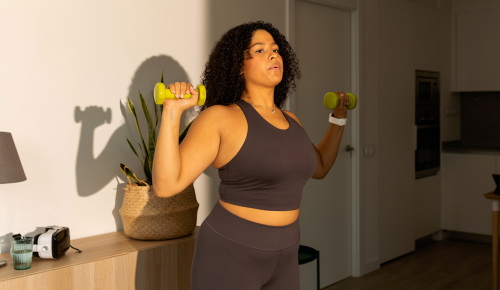Few bodyweight exercises target as many muscles as the push-up, making it a go-to for building strength anywhere. Unfortunately, many people end up pausing their push-up routine due to shoulder pain. “Shoulder pain from push-ups is fairly common,” says physical therapist and strength coachSchuyler Archambault, PT, DPT, CSCS, owner of Arch Physical Therapy & Fitness.
Experts in This Article
physical therapist at Replay PT
doctor of physical therapy and clinical assistant professor of physical therapy at Lebanon Valley College
physical therapist, strength coach, and owner of Arch Physical Therapy and Fitness
While push-ups primarily target the chest, they also rely heavily on the shoulder joint and surrounding tissues. Not only is the shoulder complex, but it’s also one of the most movable and injury-prone areas in the body, thanks to its status as a ball-and-socket joint, per StatPearls Publishing1. This makes the shoulders a prime target for pain if things go wrong during push-ups. For example, someone doing a higher volume of push-ups or not using the correct form, Archambault says.
Here, experts demonstrate proper push-up form and explain common push-up mistakes that may cause shoulder pain. Plus, they share strength and mobility exercises that can help prevent and ease push-up shoulder pain.
How to do push-ups the right way every time
Here, Anuja Ghate, PT, DPT, a physical therapist at Replay PT in New York City, demonstrates how to perform a push-up with proper form:
- 1.Start in a high plank position, with your hands shoulder-width apart, with your middle finger pointing forward. Your body should be in a straight line.
- 2.Keeping your head aligned with your back, bend your elbows and lower yourself down toward the floor.
- 3.Keep your elbows pointed back toward your hips, not flared or straight out.
- 4.Try to lower down until you almost touch the ground (or go as far as you can go without sagging your hips or flaring your elbows).
- 5.Press upward until your arms are fully straight and you are in the starting position.
Potential causes of push-up shoulder pain—and how to fix them
1. Your elbows flare
Letting your elbows flare too much (more than 45 degrees away from your body) shifts more weight onto your shoulder joint—specifically, onto the muscles in front of your shoulder joint, says Joseph Hribick, DPT, a doctor of physical therapy and clinical assistant professor of physical therapy at Lebanon Valley College.
The fix: Keep your elbows at a closer angle, ideally around 30 to 45 degrees from your torso. “This position helps distribute the force more evenly across your chest and triceps and reduces the stress on your shoulder joint,” Hribrick says.
2. Your hands are too close or too far apart
How you position your hands during push-ups can have a negative effect on your shoulders. Performing a push-up with your hands wide requires more rotation at your shoulders, which can strain the muscles and tissues that surround the joint, says Hribrick.
In addition, placing your hands too wide can increase stress on your pectoralis major (the large fan-shaped muscle in your chest), forcing this muscle to contract in a less-than-optimal position. “Because the pectoralis major attaches to the shoulder, repetitively overworking this muscle in a non-optimal position often results in shoulder pain,” Hribrick says.
At the other end of the spectrum, positioning your hands too close together forces your shoulders to rotate inward as you lower into the push-up. This position puts stress on the structures at the front of your shoulder joint, specifically your biceps tendon (the tendon that connects your biceps to your shoulder) and rotator cuff (a group of muscles that surround your shoulder joint), Hribrick says.
The fix: Position your hands just slightly wider than shoulder-width apart. Ensure they align directly under the shoulders with your fingers pointing forward, Hribrick says.
3. You don’t engage your core
A push-up is a total-body movement—that includes your abdominals and glutes that comprise your core. Letting these muscles sleep during push-ups causes your lower back to sag toward the floor. “This alters your shoulder position, causing strain on the shoulder joint and soft tissues,” Hribrick says.
The fix: “Engage your core by tightening your abdominal muscles, keeping your body in a straight line from head to heels throughout the movement,” Hribrick says. Think about drawing your belly button toward your spine.
4. You have poor shoulder mobility
“Having limited shoulder mobility can cause shoulder pain during push-ups,” Hribrick says. To do a proper push-up, your shoulder joint must be able to move within different ranges of motion. It has to extend (straighten) and rotate outward to flex (bend) your elbows as you lower your body. Then, your shoulders flex to extend your elbows when you push up.
If your shoulder mobility is limited within any of these ranges of motion, it can restrict the movement patterns necessary to do a proper push-up. These restrictions force you to change your movement patterns, which stresses your muscles and tissues surrounding your shoulder joint, including your rotator cuff and biceps tendon, Hribrick says.
The fix: Focus on improving your shoulder mobility. Perform shoulder mobility exercises (like those below) at least two to three times per week, Ghate says. If needed, see a physical therapist for a personalized shoulder mobility plan (more on this later).
5. You have weak muscles
Push-ups recruit several muscles to help control the movement of your shoulders, including your rotator cuff, trapezius (large muscles along the back of your neck and shoulders), rhomboids (muscles in your upper back), latissimus dorsi (large fan-shaped muscles in your back) and serratus anterior (large muscles along the sides of your chest). Weakness in any of these muscles can lead to poor shoulder mechanics and changes to movement patterns that strain your shoulder, Hribrick says.
The fix: Strengthen the muscles that support your shoulders during push-ups. Ghate recommends performing strength exercises (like those below) two to three times per week, giving yourself at least one rest day in between.
6. You do push-ups too often
If you’re ready to tackle a fitness goal, you may be drawn to daily push-up challenges. But doing push-ups too often can overwork your shoulder muscles and tissues. “Repetitive microtrauma due to lack of recovery time may result in inflammation of the tendons, also known as shoulder tendonitis, or other soft tissue irritation,” Hribrick says.
The fix: Take at least one day of rest between push-up sessions to reduce your likelihood of shoulder pain, Hribrick says.
Exercises that can help resolve push-up shoulder pain
1. Arm bar with rotation
This exercise improves shoulder mobility and builds stability in the shoulder joint, Ghate says.
- 1.Lie on your back on the floor with your left leg extended and right leg bent, with your right foot flat on the floor.
- 2.Use your right arm to press a dumbbell or kettlebell over your chest, palm facing your feet. Extend your left arm on the floor so it’s in line with your shoulder, palm facing down.
- 3.Keep holding the weight over your chest as you lift your right knee up and over your left leg and turn your chest to the left. Rest your right knee on the floor.
- 4.Actively press the weight toward the ceiling as you gently rotate your wrist in a clockwise direction as far as you comfortably can. Then, rotate your wrist counter-clockwise.
- 5.Perform 5 rotations in each direction before switching arms. Do 2 to 3 sets.
2. Half-kneeling windmill
The half-kneeling windmill takes the arm bar with rotation to the next level. It strengthens the muscles surrounding your shoulder joint, as well as your trunk muscles, Ghate says.
- 1.Begin in a half-kneeling position with your right leg forward. Grip a kettlebell or dumbbell in your right hand and press it overhead.
- 2.With the weight still overhead, shift your hips to the right and twist your torso. Look up at the weight as you slowly bring your left hand to the floor, keeping the arm straight and in line with your shoulder.
- 3.Reverse the movement and repeat.
- 4.Actively press the weight up toward the ceiling throughout the exercise.
- 5.Perform 2 to 3 sets of 5 to 8 reps per arm.
3. Bear shoulder tap
“This exercise targets the serratus anterior, which assists in scapular stabilization and is essential to any pushing or punching motion,” Ghate says.
- 1.Start in a tabletop position your hands and knees; align your wrists with your shoulders and your knees with your hips.
- 2.Press into your hands to push your chest away from the floor as far as you can, and lift your knees slightly off the ground.
- 3.From this position, tap your right shoulder with your left hand. Return your left hand to the floor and repeat with the opposite hand.
- 4.Keep the knees close to the ground and avoid tipping side to side.
- 5.Do 2 to 3 sets of 10 shoulder taps per side.
4. Shoulder external rotation at 90 degrees
According to Ghate, this banded exercise strengthens your rotator cuff, especially your external shoulder rotator muscles. These muscles play an important role in stabilizing the shoulder joint.
- 1.Anchor a light resistance band to a sturdy fixture at or close to ground level.
- 2.Facing the anchor point, grip the band in your left hand and pull your elbow back to shoulder level.
- 3.Begin with your arm bent at 90 degrees, forearm parallel with the floor, and palm facing down.
- 4.Step back until you feel tension in the band. Then, pull the band and rotate your shoulder until your palm faces forward.
- 5.Perform 2 to 3 sets of 15 reps per arm.
5. Seated push-up
This exercise strengthens your lats, which act as a shoulder stabilizer during push-ups. Specifically, these muscles help prevent shoulder shrugging, Ghate says.
- 1.Begin seated on a bench with a dumbbell outside each thigh.
- 2.Grip a dumbbell in each hand.
- 3.Lift your butt off the bench and push your shoulders down to elongate your neck.
- 4.Use your upper body to hover above the bench, keeping your arms straight. Hold this position for 60 seconds. Use assistance from your feet as needed.
- 5.Do 2 to 3 sets.
When to see a physical therapist
Taking a break from push-ups, tweaking your form, and performing exercises to improve shoulder strength and mobility can help ease and prevent shoulder pain. But if your shoulder pain persists for more than a few days, is sharp or severe, or limits daily activities, chat with a physical therapist, Hribrick says.
“Physical therapists are well trained in evaluating and treating shoulder pain and will perform a thorough assessment to determine the underlying cause of your symptoms,” Hribrick says.
As part of the assessment, your physical therapist will evaluate your push-up technique, movement patterns, posture, joint mobility, and muscle strength. Your physical therapist will use the assessment to create a personalized treatment plan to resolve your shoulder pain.
Sign Up for Our Daily Newsletter
Get all the latest in wellness, trends, food, fitness, beauty, and more delivered right to your inbox.
Got it, you've been added to our email list.











